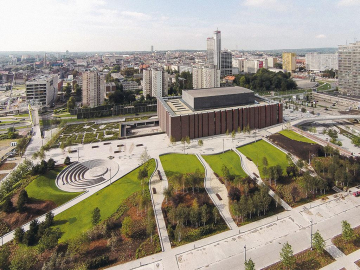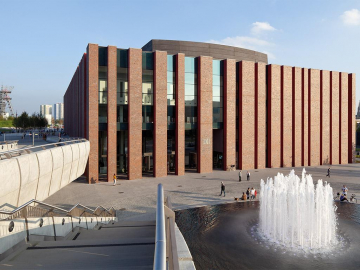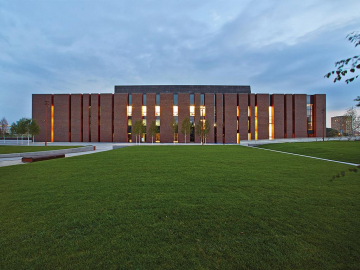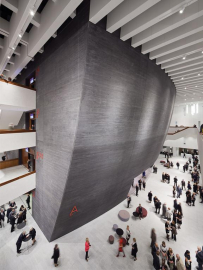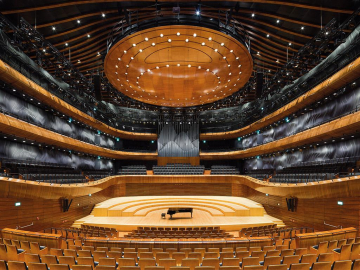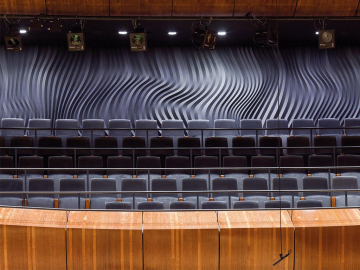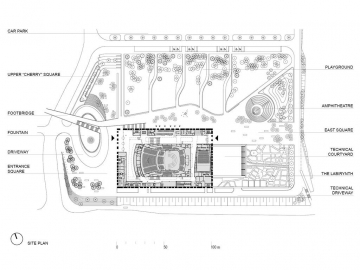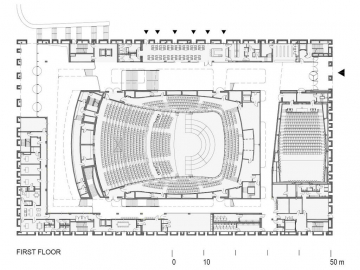The Seat of the National Polish Radio Symphony Orchestra (NOSPR)
Whatever space and time mean, place and occasion mean more. Aldo van Eyck
The centre of Katowice with 20 hectares of post-mining emptiness undergoes a revitalization on an unprecedented scale in Poland. The objective is to point the city towards culture. The buildings there are supralocal and stimulate the entire region.
The NOSPR Project was selected in an international competition. We chose a building with a simple, compact outline in the south of the 4 acre plot to keep the project close to the centre. Designing public spaces, we filled two squares and a park with 450 trees and attractions such as fountains, musical toys, a maze and an amphitheatre. The key idea was to contain a story within a story; combining to give the whole picture. Multi-layered, sensual space expressed through structure, materials, textures, light and sound which invokes emotions creating a unique atmosphere for meetings between musicians and music lovers.
The first layer is a brick monolith: cut by entrances and windows. We used a local material rough, brown outside, glassy red in niches in line with local building tradition. Modernising the traditional method of burning, we reached the desired quality and durability. We provided undisturbed acoustics by hiding noisy infrastructure within 80 external brick chimneys. We closed the rich, functional program within a simple, logical structure: the outer ring for musicians, the atrium for music lovers and inside - the hall for music three separated, yet interdependent zones. The orchestras workplace is a four-storey frame with more than 400 rooms including a chamber hall, rehearsal rooms, dressing rooms, recording studios, a canteen and small hotel.
The atrium is a multi-functional public space, as a street in a city creates background for life inside, features a variety of materials, textures, colors and forms combining the interior with the exterior. The heart of the establishment is the 1800-seat great concert hall. Its majestic presence is noticeable in every part of the building as musicians and music lovers can easily circumnavigate it. Anthracite outside, the concrete block stamped by wooden formworks is reminiscent of the old wood yard and coal mined here a decade ago. The inside is like an instrument, a play of soft shapes on the ceiling, walls and balconies with the hardness of concrete and birch plywood subordinated to the two most important aspects: acoustics and atmosphere.
The authorss technological solutions such as the spherical reinforced-concrete construction, dyed-in-the-mass shell of the hall, rubber wavy relief shuttering, plywood-formed details such as railings and seats give character.
The six-year project involved meetings with local artisans, builders, officials, investors, users, architects, specialists, world-renowned acousticians and prominent artists; all this to fill this place with people and music.
Other important sustainable aspects of the work: revitalization of central post-industrial land, demand for high-quality public space, minimized costs, compact shape, sustainable energy-saving technologies (100% LED), reference to Silesian tradition and landscape, use of local and natural materials, social activation access to culture, new jobs, appropriateness of investment a national institution.
Gross floor area: 35.059,50 m²
Area of the site: 43.255,70 m²

